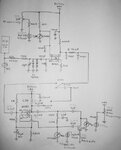neazoi
Advanced Member level 6
Hello I have designed this VLF RX for whistlers reception. I have joined together two projects (two fets) from different circuits.
The output volume of the first fet is ok for my ssd recorder.
when I connect the second stage fet, the output volume goes down very much. Being a twin notch filter, the second stage, it works ok, but it attenuated much the total volume as well. I would expect the total volume to be at least equal to that of the first stage alone, so that is why I believe there is an impedance mismatching somewhere.
I believe this is an impedance matching problem, either on the input of the first stage or in its output.
I have no idea what is the output impedance of the first stage or the input impedance of the second stage, and I do not know how to correct this.
Any suggestions???
The output volume of the first fet is ok for my ssd recorder.
when I connect the second stage fet, the output volume goes down very much. Being a twin notch filter, the second stage, it works ok, but it attenuated much the total volume as well. I would expect the total volume to be at least equal to that of the first stage alone, so that is why I believe there is an impedance mismatching somewhere.
I believe this is an impedance matching problem, either on the input of the first stage or in its output.
I have no idea what is the output impedance of the first stage or the input impedance of the second stage, and I do not know how to correct this.
Any suggestions???
